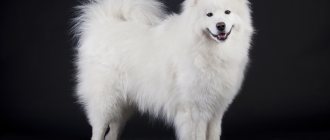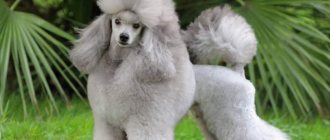The Toy Poodle dog breed is miniature and looks cute. The pet is circus and decorative. He is highly intelligent and amenable to difficult training. The Toy Poodle has an excellent temperament, and its coat is considered hypoallergenic. You can give your dog different haircuts and create unusual looks. The most important thing is for a person who wants to buy a toy poodle to know complete information about the breed. As a rule, caring for such a dog is not difficult; it is important that all management recommendations are followed.
Brief history of the breed
Northeast Africa is considered the homeland of the poodle. The breed was bred to hunt waterfowl. The dogs were then brought to Spain. The history of the origin of the poodle mentions that it was in this country that the dog began to be crossed with local breeds, among which was the Portuguese water dog.
The history of the poodle breed also has French roots. From France the breed began to spread throughout Europe. Already in the middle of the 18th century, the poodle acquired the status of a companion dog.
A modern representative of this breed is a full-fledged member of the family, a circus performer and even a home security guard.
PUPTY
After mating, the bitch requires special attention, since intrauterine development and the correct formation of the fetus are closely dependent on the state of the body of the expectant mother. The health of the future puppy can be negatively affected by an imbalance in the mother's food supply, the absence or deficiency of vitamins in the food, insufficient exercise of the pregnant bitch, as well as untreated wounds, worms, etc. If the feces of the dogs involved in mating have not been tested for worm eggs, then 10-15 days after mating the bitch should be given an anthelmintic medication. Giving your dog anthelmintic drugs after the thirtieth day of pregnancy is not recommended. Very serious attention should be paid to the walking of a pregnant dog: throughout pregnancy, she should walk at least two hours a day. From the day of mating until the end of the puppies' feeding period, the bitch is given calcium glycerophosphate, calcium gluconate or calcium phosphate (from 0.1 to 1 g per day) in her food. In the absence of mineral salts, it is necessary to give the dog meat and bone or fish and bone meal in the same doses. The pregnancy state lasts from 58 to 63 days. From the thirtieth day, the dog is carefully monitored, activities and games associated with sudden movements and significant stress are stopped. The dog owner is usually concerned about whether pregnancy has occurred. However, there are no reliable signs of pregnancy in a dog in the first four weeks after mating. The dog may be sad and lethargic, drink and eat a lot, or vice versa. In the fifth week after mating, her nipples swell, acquire a pale pinkish color, and colostrum begins to separate. Mucus discharge is observed from the vagina. By the sixth week, the belly increases, the dog begins to build a nest, but it is still impossible to say for sure that pregnancy has occurred. Clarity comes by seven to eight weeks, when it is already possible to feel the movement of the fetuses, which is a reliable sign of pregnancy. Owners of mated bitches should be fully aware of the need for constant contact with a veterinarian during both the preparation of the dog for mating and whelping. The doctor will not only observe the dog, but will also tell the inexperienced fan how to behave and what assistance to provide to the dog and puppies, if the need arises. During pregnancy, not only external changes are observed in the structure of the dog’s body, but also changes in metabolism occur. The endocrine glands begin to work intensively. The amount of blood increases - by 20-25% by the end of pregnancy. The explanation is simple: it is necessary to nourish the developing fruits and remove unnecessary metabolic products from them. The dog’s cardiovascular system works in accelerated mode: the pulse quickens and the number of respiratory movements increases. The process of gestation usually proceeds favorably if the dog is provided with good living conditions. The most important components of a dog's food are: proteins, fats, carbohydrates, minerals, water and vitamins.
Interesting Facts
Interesting facts about the breed:
- In Goethe's philosophical drama Faust, Mephistopheles appeared in the guise of a black poodle. It is known that the author himself was not a fan of these dogs and was even afraid of them.
- For a long time Beethoven could not come to terms with the death of his poodle. This forced him to create “Elegy” in honor of his favorite. The breed is also mentioned in the works of Tarber, Seewald, and Heine.
- In the 14th–16th centuries, this breed served as the so-called “weapon” of Spanish men. Due to the ban on dueling, they trained dogs to mark the house of their ill-wishers. Such entertainment was appreciated by brave young men, and puppies of this breed began to be called “tailed challenge.”
Searching for a spouse.
The search for a partner for a bitch should begin after a conversation with the breeder. Maybe he will not only advise which manufacturer to choose, but also give the address and telephone number of its owner. You need to look for a spouse for your bitch among the males who already have show grades and permission to breed. If you are not sure about the right choice, seek help from the club’s dog handler and, of course, your breeder. A female dog's heat lasts approximately 21 days. As a rule, fertile days (when there are the most mature eggs) occur on days 11-13 of estrus. Although there are significant individual deviations - from 8 to 21 days! A bitch in heat should be protected from accidental matings. When walking, don’t let even your Obedience Champion off the leash. The instinct to procreate is the strongest. What to give a poodle? How and what to feed a poodle puppy and an adult pet? When talking about dog nutrition, many owners immediately decide that the main food is meat. However, only meat feeding can kill a dog. From the very first days, a reasonable owner will establish a balanced diet, including a sufficient amount of proteins, fats, vitamins for dogs, minerals and trace elements. A poodle's diet should consist of animal and plant foods containing all the substances necessary for the body.
It has been established that to ensure the normal functioning of a dog’s body, 1 kg of body weight per day requires: proteins 4-5 g, fats - 1-2, carbohydrates - 12-15, mineral salts - 8-10 g; vitamins: A – 1-5 mg, B1 – 0.5, C – 10, B2 – 2-3, PP – 10 mg.
Standards and appearance
This is the only breed that has many varieties. Poodle dogs differ in size, color and coat type. Everyone has the opportunity to choose the most suitable pet for themselves.
Description of the poodle breed standards:
What are the difficulties of breeding poodles?
— The difference in determining growth boundaries in the Anglo-American standards and the FCI standard. — The common origin of poodles of three small varieties, mixed breeding and, as a result, a wide variation in height and type among puppies of the same litter. — The presence of clear intra-breed types, sometimes so different that it’s time to talk about different breeds. — Different approaches to assessing colors in the FCI standard (strictly 5 colors) and the countries leading in modern poodle breeding (USA - “any uniform color”). The result is the appearance of puppies of non-standard (according to the FCI, namely the French Poodle Club) colors. — black breeder`s, wilde breeding, “sovok”-mentality. That is why careful selection of the parent pair and knowledge of the ancestors (at least height, color) are so important in breeding poodles.
Breed varieties
Types of poodles depending on size:
Descriptions:
Color and coat type
The description of the poodle breed mentions the variety of shades of coat. According to the FCI standard, there are 6 colors of poodles:
- black;
- white;
- silver;
- brown;
- apricot (pink);
- red (red).
However, when crossing dogs with different coat colors, puppies with non-standard colors are born (brindle, sable, silver-beige, cream, two-color, etc.).
Depending on the type of wool, they are divided into two types:
Black
The black poodle is a classic representative of the breed, which is considered the most common.
The description of the breed states that the color should be bright, intense, without a hint of other shades. It is unacceptable for light or silver hairs to show through. The skin should be dark, gray or blue-gray. The color of the eyelids, nose, lips and claws corresponds to the shade of the coat.
On a note. This poodle has a denser and higher quality coat compared to other representatives of the breed.
Silver
The silver poodle is a rare specimen, because achieving the ideal shade that meets the breed standards is quite difficult.
Description: Silver color represents all shades of gray, but the presence of black or white hairs is not allowed.
At birth, puppies are black in color, but as they approach two months, the coat begins to lighten, and silvery areas appear on the paws and face. The gray poodle has identical skin color. The nose, eyelids and lips are black, and the eyes are brown.
Brown
Description of the species: the wool has a rich brown tint, close to chocolate. The skin color of brown poodles matches the main color. The nose can be any shade of brown.
Interesting fact. The darker the nose of a chocolate poodle, the more likely it is to win first place at the show.
The eyelids, claws and lips are black or brown.
Apricot
Individuals have apricot-colored fur, which becomes pinkish with age. The presence of white or brown hairs is a disqualifying feature. According to the species description, the dog's ears should be brighter than other parts of the body.
With age, the pink poodle loses the richness of its shade, its coat becomes creamy.
The Peach Poodle has pink skin with a blue or gray tint.
The eye color of representatives of the species is brown, and the claws, lips and eyelids are black.
Red
Description of the species: individuals are distinguished by a rich, bright red hue. As your Red Poodle puppy ages, his coat may change and become less rich. The skin color of a red poodle does not differ from the coat color.
What color should I get a poodle?
You can choose a poodle based on color to suit every taste. White poodles are the most attractive and photogenic, but there are many more worries with them than with a poodle of any other color. Usually, only very clean people risk keeping snow-white poodles. Dreamy people prefer pink or apricot. Blue and anthracite dogs are suitable for any person. From the point of view of care, the most practical thing is to choose a poodle of either a rather rare brown or black color. They are cute in their own way and easier to care for.
Character and behavior
The character of a poodle does not depend on the type and color of its coat. Attentiveness, obedience, playfulness and a sense of humor - this is what the poodle is all about.
He is careful with strangers, and these habits allow the dog to be a good watchman in the apartment. And thanks to their high intelligence and cheerful character, dogs take part in circus performances and canine competitions.
Description of the differences between females and males: a girl poodle has an easy-going but artistic character, while boys are more independent, perky and courageous.
Poodle and children
The characteristics of the breed indicate that the poodle is an ideal candidate for a family with a child. He is patient and kind towards children.
Dogs also get along well with other pets. There may be minor problems with representatives of the cat family, but if you pay due attention to raising the puppy, living together with a cat will not cause any problems.
Photo gallery
In general, we can say that representatives of the breed are not very easy to care for, primarily because of their coat. But what is 10 minutes a day when it comes to your beloved pet?
Care and maintenance
Poodle care must be carried out on an ongoing basis. The owner should pay attention to the professional haircut of his pet. This procedure should be carried out every six months.
Caring for a dog is not easy, because in addition to grooming, it needs to be bathed regularly, and it is also important to provide a balanced diet.
The right diet
Creating a menu is a responsible task for the owner. Initially, owners need to decide what food to give their pet - natural or dry.
If the choice was made in favor of “natural” food, it is important to organize nutrition in such a way that the diet is rich in proteins, fats and carbohydrates.
Regardless of how old the poodle is, its daily diet should include meat and offal. Boiled eggs can be given to the animal as a source of protein and fat.
Once every 7 days, meat products can be replaced with fish. Small puppies should include dairy products such as kefir, cottage cheese, fermented baked milk, and yogurt without additives in their diet.
Carbohydrate-rich cereals: rice, buckwheat and oatmeal. The norm for adults is about 500 g per day. The menu must be supplemented with vegetables and fruits. The list of permitted foods includes carrots, beets, greens, and apples. If your dog does not have enough vitamins, you should contact your veterinarian to select the optimal vitamin and mineral complex.
Important. It is necessary to provide the dog with access to fresh, clean water.
It is strictly forbidden to include the following products in the diet:
- fresh baked goods;
- smoked, salty and fatty foods;
- canned food;
- poultry bones, beef ribs;
- confectionery;
- thick porridge;
- legumes
When choosing dry food, it is recommended to focus on its composition and manufacturer. You should not give preference to cheap, low-quality products, because their introduction into your pet’s diet can result in serious problems for the dog’s health.
Walking and physical activity
Since this breed is energetic and active, walks should be long and regular. If the song receives proper loads, it will begin to splash out energy in the apartment. The pet will start tugging at toys, gnawing on wires, furniture, and shoes.
Training and education
Training a poodle involves engaging in intellectual exercises. You need to play games and agility with your pet.
Trained poodles have an excellent memory, so they can easily remember hundreds of commands.
You need to start training your puppy from an early age. You can train your dog at home. A novice dog breeder and even a school student can cope with this task.
Note. If the owner makes mistakes in upbringing, this can forever change the habits and behavior of the animal. It is important to know the dog’s character traits, then training a poodle will be much easier.
Hygiene
You can bathe your dog no more than 2-3 times a month. Special attention should be paid to daily combing. To care for your pet, you need to choose cosmetics that will make it easier to care for the coat and prevent it from matting.
Ears and eyes need constant examination. If discharge is detected, you should contact your veterinarian.
It is recommended to trim nails 1-2 times a month.
Vaccinations and susceptibility to disease
It is important to pay due attention to animal vaccination, because it is considered the key to good health. Before vaccination, it is necessary to carry out deworming and flea treatment.
The first vaccination against distemper and parvovirus should be given to the puppy at the age of 1.5–2 months. After 2–4 weeks, revaccination is necessary.
On a note. The dog is in good health, but its eyes may often water.
Poodles are a long-lived breed, but they are not immune to certain diseases, most of which are inherited.
Poodle diseases:
- bloating;
- von Willebrand disease;
- glaucoma;
- deafness;
- otitis;
- allergy;
- epilepsy;
- early gray hair;
- diabetes.
Caring for puppies
When caring for a poodle puppy, you need to pay attention to proper feeding and vaccinations. Until the age of one month, for the animal to fully develop, it is enough to feed on mother’s milk. When the puppy reaches one month, the first complementary foods should be introduced into the menu in the form of chopped lean meat and wet food.
Lifespan
With good maintenance and care, dogs can live up to 12–14 years. In addition, life expectancy is affected by past diseases and heredity.
Puberty, mating
Puberty in dogs begins early. Females usually reach sexual maturity at 6-8 months of age, males at 12-16 months of age. At this time, animals experience a desire to copulate. Dogs, especially females in heat, must be carefully monitored to prevent early and unwanted mating.
True physical development in bitches is completed only at the age of 18–24 months. Males are allowed to breed from 18 months. To breed poodles, you should use bitches over 24 months of age.
During the year, the bitch has two sexual cycles with an interval of 6 months. Each sexual cycle ends with estrus, or mating. At this time, the dog experiences swelling and an increase in the size of the external genitalia, mucus is released from the genital slit, initially bloody, on the eighth to tenth day reddish, then lighter.
Discharges have a specific property - they serve to transmit information to the opposite sex about the bitch’s readiness for reproduction and spread over long distances. The dog at this stage becomes playful and easily excitable. In a current bitch, the mammary glands sometimes become enlarged, and milk may be released in small quantities. During this period, the bitch should be walked only on a short leash and accidental matings should not be allowed.
Mating is carried out on days 9-14 from the date of the start of estrus. Only healthy animals, previously examined by a veterinarian, are allowed to breed. There are two methods of knitting: freestyle and manual. Freestyle mating: the dog and the bitch are left together for a while. This method is used when the bitch shows a clear interest in the male, and the latter already has some experience. When hand-knitting, animals are given assistance. This method is used when mating a young bitch who, when a male dog approaches, behaves restlessly and snaps. It is recommended to put a muzzle on the bitch to prevent her from biting the dog. During mating, the bitch must be caressed, holding the collar with one hand and the belly with the other.
Mating is best done in the morning, before feeding, after walking the dogs well.
Before the end of sexual intercourse, it is prohibited to forcibly separate animals.
The second, control, mating is usually carried out to ensure that the bitch is fertilized one or two days after the first.
The mating dates are recorded and the estimated due date is determined from them.
Summary of Pros and Cons
Description of the pros and cons of the poodle breed.
AdvantagesDisadvantages
| Hypoallergenic wool without odor | Prone to barking loudly |
| Well trained | Can't stand noise |
| They love children | Need proper and regular care |
| Loyal to the owner | Are prone to genetic diseases |
| Lack of aggression towards people and other animals |
When choosing a pet, it is important to study all the information about the breed, take into account the characteristics of its maintenance and predisposition to diseases.
With proper upbringing and proper care, the poodle will become a cheerful and reliable friend for the whole family and will live a long and happy life.
Male or female?
For many people, the gender of the dog they buy is not indifferent. Bitches, as a rule, are more affectionate and affectionate, have a more subtle and rich psyche, are smarter than males, are easier to train and are toilet trained. These qualities completely smooth out some possible inconvenience for the owner caused by females twice a year during the period of emptying and the birth of puppies. Males are more elegant, stricter and more aggressive than females, and require longer walks. It is believed that if a family is raising a boy, then it is better to purchase a male, and if a girl, then a female. Who should I choose? This must be attributed entirely to the desires, intuition and individuality of the owner.
FALSE PUPTY
5-8 weeks after the end of estrus, the dog's nipples may become enlarged and other signs of true pregnancy may appear. This is the so-called false, or imaginary placiness. Dogs drag toys to their place, place them under the nipples from which milk flows, and take the pose of a nursing mother. They go outside reluctantly, after a short walk they hurry home, rush to the toy “puppies”, sniff and lick them... Helping the dog in this case consists of changing the feeding diet and giving it sedatives. Dairy products are completely excluded from the diet. You should not express milk from your dog's nipples. It is necessary to consult a veterinarian. The doctor will prescribe the dog sedatives and psychotropic drugs in appropriate doses and the dog will quickly recover.
Training
- The breed is considered very smart (the second most intelligent dog in the world) and is easy to train. The miniature poodle easily learns new commands and remembers what it has learned for a long time. Education should be consistent and begin from the first weeks. You can train a puppy from the age of 3-4 months. First of all, the “place” command is taught, followed by the study of other simple commands: “near”, “to me”, “give”, “sit” and other commands.
- Training is carried out using praise, encouragement, and positive stimulation. Puppies love to be praised. An inquisitive mind helps you easily master complex commands and tasks. The poodle has a good sense of smell and memory; when lost, it does not panic and easily finds its way home, even many kilometers away.
- Particular attention should be paid to hygiene ; a miniature poodle puppy should be taught it from an early age. This includes trimming fur and claws. Having become accustomed to procedures in childhood, an adult poodle will not become capricious or snap during these actions.
The most popular haircuts
A haircut is required every 2 months at home or in a salon.
- A lion. The fur is cut on the back of the body to the ribs, as well as the paws, muzzle and tail. Pompoms remain at the ankles and the tip of the tail.
- Modern. With a modern haircut, the hair in the area of the muzzle, back and croup is removed, the belly and sides are trimmed to a length of 1 cm.
- Bikini. The bikini cut involves short hair all over the body, with pompoms remaining at the ankles and tail.
How to choose your future pet?
The choice of a poodle puppy must be careful, because everyone wants to have a real puppy, and not a mixed breed or a fake that unscrupulous breeders want to sell.
What to pay attention to:
- Examine the candidate. His coat should be shiny, curly and without any bald spots or bald spots.
- The limbs must be intact, the tail without kinks.
- Nothing should flow from the nose or ears, and there should be no unpleasant odor from the mouth.
- There should be no lameness when walking or running.
- Check your puppy's tummy to see if it is bloated or not.
- See how he eats, check his appetite.
- The dog should not show aggression or fear. A healthy puppy shows curiosity, is playful and cheerful, and is not lethargic.
- Look at the parents and how they behave, because the future behavior of the puppy largely depends on the temperament of the parents.
- If purebred is a decisive criterion for you, then ask the breeder to show all the documents for the parents, check the brands in a special database.
NOTE!
The price of a poodle puppy depends on many factors, but on average it varies from 25 to 35 thousand rubles.
How to toilet train?
Toilet training a puppy should be done in several stages:
- Set up a place where your dog can go when he needs to. This can be done even before it appears.
- Remember that babies go to the toilet often. Watch and you will see that this happens after every meal. If the puppy begins to sniff the floor and spin around restlessly, then it’s time to take him to the place that you have equipped for him. If he did everything right, then praise him with a treat.
- If your pet still didn’t have time or didn’t make it, then don’t rush to punish or scold him. Remember that he is still a child and does not quite understand what they want from him.
- If you see that the dog has started doing business in the wrong place, then shout sharply to it and immediately take it to the toilet. There, if everything ends successfully, praise him.
- Once your pet has received all its vaccinations, you can train it to go to the toilet outside. Remember that puppies often have to manage things, so at first you will have to walk him 5-6 times a day. Whenever successful, praise him and give him a treat.
- First, go for walks with him at the same time so that he gets used to the walking schedule. If you see that he asks outside your walking period, then take him for a walk anyway.
- Don’t rush to remove the litter box right away, because the dog won’t be able to tolerate it for long. As he gets older, he will need to go to the toilet less often, only then his place in the house can be cleaned.
NOTE!
Toilet training is an important period in a dog's life. You need to show as much patience as possible and not go too far with punishments. It is absolutely forbidden to hit a puppy, this will have a negative impact on his psyche.
PUPPING
Pupping, as a rule, is not unexpected.
Usually, some signs appear that can be considered as harbingers of childbirth - a sagging belly, refusal to feed, etc., but above all - anxiety: the dog tears up the bedding, prepares a “nest” for itself, changes places, whines, hides in dark corners, often seeks help from the owner. In addition, before childbirth the following phenomena are observed: the external genitalia swell and mucus is released from them. The size of the nipples and mammary glands increases, and colostrum appears. But some dogs produce colostrum later, sometimes during or immediately after birth. At the first signs of labor, it is necessary to wash the external genitalia, abdomen, perineum, inner thighs with warm water and toilet soap and wipe dry. The birthing area must be provided with clean bedding, and it must be of such size that the dog can stretch out while lying on its side. During birth, bedding must be changed, ensuring that the dog and newborns are dry at all times. For childbirth, you should prepare a “birth kit”: a set of clean gauze napkins, cloth napkins, 5% iodine tincture, boiled linen threads, scissors. Have hot water on hand if you need to revive a puppy with breathing problems. You shouldn't be afraid of childbirth. They usually proceed without serious complications. Contractions (periodically repeated wave-like contractions of the uterine muscles) are the main force of labor. During contractions, the uterus opens and the fetus is further expelled. The children's place is also displayed. At the beginning of labor, uterine contractions are not so noticeable, but later they gradually intensify and soon become maximum in strength. Then the muscles of the uterus relax, and there is a pause. During one of the contractions, light amniotic fluid is released. This is fine. The second period is the actual birth, pushing. Pushing is a contraction of the muscles of the uterus with simultaneous rhythmic contraction of the muscles of the abdominal wall and diaphragm. Attempts in a dog appear after the uterus dilates and occur reflexively. Within certain limits, they can be enhanced or restrained by the dog itself. Thus, efforts that increase intraperitoneal pressure and contractions create conditions for the fetus to come out. During a normal birth, the dog's assistance is limited to monitoring the birth and delivering the newborns. The reception of a newborn is as follows. Immediately after birth, the puppy’s mouth and nose must be cleared of mucus and amniotic fluid by inserting a gauze swab into the puppy’s mouth and immediately pulling it out. Mucus and amniotic fluid that enters the puppy’s mouth are quickly absorbed into dry gauze and do not cause further complications. After treating the oral cavity, the umbilical cord and wiping the puppy dry, give it to the mother, who will lick it, then place the newborn on the nipple and, if necessary, help him take the nipple, i.e. spreading the fur around the nipple, lightly press on it until colostrum appears and place the puppy’s lips on the nipple. You should also make sure that the dog does not crush the cubs near it during subsequent contractions. For a while, they can be moved to the side or placed in some clean box on a litter with a heating pad placed under it. The puppies should not be taken away; the mother should see them and be calm for them. The puppy may walk head or rear first, which does not matter if the bladder and umbilical cord are intact. If the puppy walks backwards, you need to help him get out, otherwise he may choke. At the moment when the bitch is pushing, you need to take with your hand what is sticking out and pull it out and down. The bitch herself opens the amniotic sac and bites the umbilical cord, separating it from the placenta. If the umbilical cord is long and the placenta does not come out after the puppy, then after biting it remains in the birth canal and should come out before the next puppy.
Dossier
Adult height: 28-38 cm. Weight: 7-8 kg. Characteristic color: coat color can be white, gray, black, apricot, brown. Coat length: long, up to 20 cm. How long does a miniature poodle live: from 12 years to 15 years. Advantages of the breed: very cheerful, playful and friendly dogs. The breed is distinguished by good trainability and high intelligence. Wool does not cause allergies. Difficulties of the breed: jealous, do not tolerate loneliness well. Average price: 150-450 US dollars. Classification: small breed, decorative, apartment, companion dog.
Vaccination schedule
Puppies up to one year old will need the following vaccinations:
- 8-10 weeks is the first vaccination for a puppy against parvovirus enteritis, viral hepatitis and distemper;
- 11-13 weeks - second vaccination against parvovirus enteritis, viral hepatitis and plague. At this time, the puppy receives its first vaccination against rabies.
If the risk of contracting rabies is low, for example, the puppy does not come into contact with carriers of the virus, then vaccination can be delayed until 6-9 months.
Development by months
How does a poodle puppy develop from 1 to 12 months:
Poodle puppies grow up to a year inclusive, and their growth gradually slows down as they approach 12 months of age. To know which month the growth corresponds to, it is necessary to take measurements and compare them with the standard .











